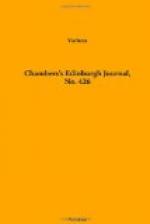’Monday night (January 12), between the hours of nine and ten o’clock, a frightful calamity occurred at 140 Centre Street, in a rear building owned by the Commissioners of Emigration, for the reception of the newly-arrived emigrants. The building is five storeys high, and each floor appropriated for the emigrants—the upper rooms principally for the women, and the lower part for the men. In this place, six human lives were lost, and perhaps as many more may yet die from the injuries sustained. It seems that between nine and ten o’clock, the City Hall bell rang an alarm of fire in the fifth district, and some of the women on the upper floors called out “fire,” which instantly created a panic of alarm on each floor among them, and a general rush was made for the stairway, which being very contracted, they fell one on the top of each other, creating an awful state of confusion. So terrified were some, that they broke out the second and third storey windows, and sprang out, falling with deadly violence in the yard below. The screams and cries of the affrighted women and children soon called the aid of the police; and Captain Brennen, aided by his efficient officers, rendered every assistance in his power, and succeeded, as quickly as possible, in extricating the injured as well as the dead from the scene of calamity. Six dead bodies were conveyed to the station-house, and eight persons were conveyed to the city hospital with broken arms and bodily injuries, some of whom are not expected to survive. Many others were injured, more or less, but not deemed sufficiently so to be sent to the hospital. Those killed are all children, except one, who is a young woman about twenty years of age. They were all suffocated by the number of persons crowded on them. The scene at the Sixth Ward Station-house presented a woful sight, the mothers of the deceased children bewailing over them in the most pitiful manner. At the time the alarm was given, there were about 480 emigrants in the building, the larger proportion women and children, who were up stairs; and in forcing their way down stairs, the balusters gave way, thus precipitating them down in a very similar manner to the unfortunate children at the Ninth Ward School-house. There was, it seems, no cause for the alarm of fire any more than the bells rang an alarm; which alarm did not refer to that district, but was misconstrued by the emigrants to be in their building. Alderman Barr was quickly on the spot, rendering every assistance in his power to alleviate the sufferings of the poor unfortunate emigrants.’
The details of these two calamities arising from sheer panic will not be useless, if they serve to shew the extreme danger and folly of giving way to a terror of fire in crowded buildings. Let us impress upon all the necessity for so disciplining their nerves, that on hearing a call of fire in a church, theatre, or other place of assemblage, they may act with calmness and common sense; those nearest the door going out,




